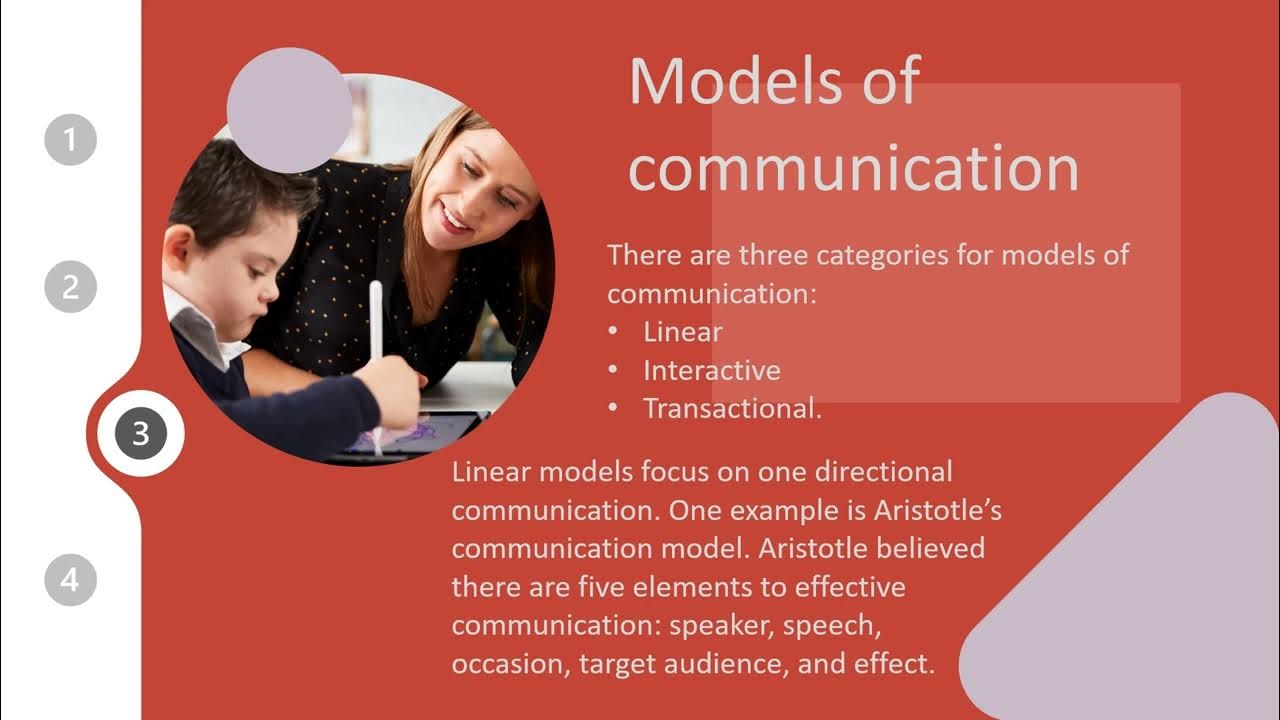Models of Communication
Summary
TLDRThe script delves into various models of communication, starting with the linear model, which involves a sender, message, and receiver in a straightforward process. It then explores the transactional model, emphasizing the interactive nature of communication with feedback loops. The script also touches on the Helical Model, adding a dimension of continuous improvement. Throughout, it highlights the importance of understanding the components and processes involved in effective communication, including the role of feedback and the impact of technology on modern communication methods.
Takeaways
- 😀 The script discusses various models of communication, emphasizing their importance in understanding the process of exchanging information.
- 🔍 The linear model of communication (LMT) is highlighted as a foundational concept, describing a one-way process from sender to receiver.
- 🔄 The script introduces the concept of feedback in communication, showing its role in improving interaction and understanding between the sender and receiver.
- 📈 The transactional model is presented as an advancement over the linear model, illustrating the continuous and reciprocal nature of communication.
- 🌐 The interactive model of communication is discussed, emphasizing the role of the internet and new technologies in facilitating two-way communication and feedback.
- 📚 The Helical Model, introduced by Watzlawick, Beavin, and Jackson in 1967, is mentioned as a three-dimensional representation of communication, involving constant feedback and interaction.
- 🗣️ The importance of the sender and receiver's roles in the communication process is underscored, including the need for clarity and active participation.
- 🔗 The script touches on the elements of communication, including the speaker, message, channel, and feedback, and how they interconnect to convey meaning.
- 👥 The disadvantages of the interactive model are briefly mentioned, such as the potential for delayed feedback and indirect experiences in online communication.
- 🌟 The script concludes by emphasizing the relevance of understanding different communication models to effectively navigate the complexities of modern communication channels.
- 📘 The overall takeaway is the evolution of communication models from linear to interactive and transactional, reflecting the dynamic nature of human interaction in various mediums.
Q & A
What is the main focus of the video script?
-The main focus of the video script is to explain different models of communication, including the linear model, transactional model, and the interactive model, as well as the elements and processes involved in communication.
What is the Linear Model of Communication?
-The Linear Model of Communication, also known as the DCI model, is a one-way process where the sender sends a message to the receiver without any feedback or interaction.
What are the five primary elements of the Speech Act IT model?
-The five primary elements of the Speech Act IT model are the Speaker, the Speaker's location, the Message, the Channel, and the Receiver.
What is the concept of 'feedback' in the context of the Linear Model?
-In the context of the Linear Model, 'feedback' is not a part of the model as it is a one-way communication process without any response or reaction from the receiver.
What is the Transactional Model of Communication?
-The Transactional Model of Communication is a two-way interactive process where the roles of sender and receiver are interchangeable, and feedback is an integral part of the communication process.
What are the disadvantages of the Interactive Model of Communication?
-The disadvantages of the Interactive Model include the potential for slower feedback, indirect examples, and sometimes the feedback can take a very long time, leading to misunderstandings or misinterpretations.
What is the Helical Model of Communication proposed by Watzlawick, Beavin, and Jackson in 1967?
-The Helical Model of Communication, also known as the 'Pigeon Hole Model,' is a three-dimensional representation of communication that emphasizes the continuous and reciprocal nature of communication between the sender and receiver.
What is the role of 'noise' in the Shannon-Weaver Model?
-In the Shannon-Weaver Model, 'noise' refers to any interference or distortion that affects the clarity and accuracy of the message being transmitted from the sender to the receiver.
How does the script describe the process of communication in the Interactive Model?
-The script describes the process of communication in the Interactive Model as involving exchange, corporate speed back, and full peer-to-peer communication, making the process more engaging and dynamic.
What are the key takeaways from the script regarding the importance of understanding communication models?
-The key takeaways are the importance of understanding the different communication models to improve communication effectiveness, the role of feedback in two-way communication, and the evolution of communication models with new technologies like the internet.
How does the script relate the models of communication to everyday experiences?
-The script relates the models of communication to everyday experiences by using examples such as watching a romantic show on television and interacting with people, illustrating how communication models can be applied in personal experiences.
Outlines

This section is available to paid users only. Please upgrade to access this part.
Upgrade NowMindmap

This section is available to paid users only. Please upgrade to access this part.
Upgrade NowKeywords

This section is available to paid users only. Please upgrade to access this part.
Upgrade NowHighlights

This section is available to paid users only. Please upgrade to access this part.
Upgrade NowTranscripts

This section is available to paid users only. Please upgrade to access this part.
Upgrade Now5.0 / 5 (0 votes)





